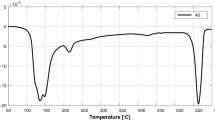Abstract
In order to study the size effect on the AE rate ‘a’ value, three kinds of mix ratios were set up by different particle sizes and water cement ratios, 45 cement mortar specimens with five different heights were tested under axial compression. And the whole damage processes were monitored by full-digital acoustic emission acquisition system, followed by an analysis of mechanical behavior and AE activity. The experimental results show that the height of the cement specimen has significant effects on the compressive strength and the acoustic emission rate ‘a’ value, but a slight effect on the accumulated AE hits number, which is analyzed from aspects of failure process of cement mortar specimens.
Similar content being viewed by others
References
Sagar RV, Prasad RV, Prasad BK R, et al. Microcracking and Fracture Process in Cement Mortar and Concrete: A Comparative Study Using Acoustic Emission Technique[J]. Experimental Mechanics, 2013, 53(7): 1161–1175
Haneef TK, Kumari K, Mukhopadhyay CK, et al. Influence of Fly Ash and Curing on Cracking Behavior of Concrete by Acoustic Emission Technique[J]. Construction and Building Materials, 2013, 44: 342–350
Carpinteri A, Lacidogna G, Niccolini G. Damage Analysis of Reinforced Concrete Buildings by the Acoustic Emission Technique[J]. Structural Control and Health Monitoring, 2011, 18(6): 660–673
Saliba J, Loukili A, Grondin F, et al. Identification of Damage Mechanisms in Concrete under High Level Creep by the Acoustic Emission Technique[J]. Materials and Structures, 2014, 47(6): 1041–1053
Saliba J, Loukili A, Grondin F, et al. Experimental Study of Creepdamage Coupling in Concrete by Acoustic Emission Technique[J]. Materials and Structures, 2012, 45(9): 1389–1401
Grosse CU, Ohtsu M. Acoustic Emission Testing[M]. Springer Science & Business Media, 2008
Ohtsu M. Rate Process Analysis of Acoustic Emission Activity in Core Test of Concrete[J]. Concrete Library JSCE, 1992, 20: 143–153
Ohtsu M, Watanabe H. Quantitative Damage Estimation of Concrete by Acoustic Emission[J]. Construction and Building Materials, 2001, 15(5): 217–224
Su HZ, Tong JJ, Hu J, et al. Experimental Study on AE Behavior of Hydraulic Concrete under Compression[J]. Meccanica, 2013, 48(2): 427–439
Watanabe T, Hosomi M, Yuno K, et al. Quality Evaluation of Shotcrete by Acoustic Emission[J]. Construction and Building Materials, 2010, 24(12): 2358–2362
Suzuki T, Ogata H, Takada R, et al. Use of Acoustic Emission and X-ray Computed Tomography for Damage Evaluation of Freeze-thawed Concrete[J]. Construction and Building Materials, 2010, 24(12): 2347–2352
Suzuki T, Ohtsu M, Shigeishi M. Relative Damage Evaluation of Concrete in a Road Bridge by AE Rate-process Analysis[J]. Materials and Structures, 2007, 40(2): 221–227
Ishibashi A, Matsuyama K, Ohtsu M. AE Application for Diagnosis of Deteriorated Concrete of Harbor Structures[J]. Proc. 6th Int. Sym. on AE from Composite Materials, 1998: 145–152
Suzuki T, Ohtsu M. Quantitative Damage Evaluation of Structural Concrete by a Compression Test Based on AE Rate Process Analysis[J]. Construction and Building Materials, 2004, 18(3): 197–202
Carpinteri A, Lacidogna G, Pugno N. Structural Damage Diagnosis and Life-time Assessment by Acoustic Emission Monitoring[J]. Engineering Fracture Mechanics, 2007, 74(1): 273–289
Ohtsu M, Suzuki T. Quantitative Damage Estimation of Concrete Core Based on AE Rate Process Analysis[J]. Journal of AE, 2005, 22: 30–38
Qian L. Damage Evaluation of Concrete Based on Acoustic Emission Technique[D]. Wuhan: Huazhong University of Science and Technology, 2005 (in Chinese)
Kani GN. How Safe are Over Large Concrete Beams[J]? Am. Concr. Inst., 1960, 56(9): 1469–1479
Cotterell B, Mai YW, Lam KY. Statistics and Size Effect in Cementitious Materials[J]. Cement and Concrete Research, 1995, 25(2): 408–416
Yang G, Hikosaka H. Crack Length and Specimen Size Influences on Fracture Strength of Brittle Materials[J]. Construction and Building Materials, 1996, 10(8): 565–570
Koc V, Sener S. Size Effect in Normal-and High-strength Concrete with Different Notches under the Axial Load[J]. Journal of Materials in Civil Engineering, 2009, 21(9): 433–445
Ince R, Arici E. Size Effect in Bearing Strength of Concrete Cubes[J]. Construction and Building Materials, 2004, 18(8): 603–609
Hu X, Duan K. Size Effect and Quasi-brittle Fracture: the Role of FPZ [J]. International Journal of Fracture, 2008, 154(1–2): 3–14
Glucklich J, Cohen L J. Size as a Factor in the Brittle-ductile Transition and the Strength of Some Materials[J]. International Journal of Fracture Mechanics, 1967, 3(4): 278–289
Wang ZY, Su XY. The Effects of Shape Factors on the Concrete Strength Grade[J]. Sichuan Building, 2006, 26(4): 144–145(in Chinese)
Kim JK. Size Effect in Concrete Specimens with Dissimilar Initial Cracks[J]. Magazine of Concrete Research, 1990, 42(153): 233–238
Dyskin AV, Van Vliet MRA, Van Mier JGM. Size Effect in Tensile Strength Caused by Stress Fluctuations[J]. International Journal of Fracture, 2001, 108(1): 43–61
Karihaloo BL, Abdalla HM, Xiao QZ. Deterministic Size Effect in the Strength of Cracked Concrete Structures[J]. Cement and Concrete Research, 2006, 36(1): 171–188
Liu HY, Zhang JQ, Cheng SS, et al. Study on Compressive Strength of Concrete Core Samples [J]. Concrete, 2012(2): 36–38 (in Chinese)
Ji HG, Zhang T Sen, Cai MF, et al. Experimental Study on Concrete Damage by Dynamic Measurement of Acoustic Emission[J]. Chinese Journal of Rock Mechanics and Engineering, 2000, 19(2): 165–168
Author information
Authors and Affiliations
Corresponding author
Additional information
Funded by the National Natural Science Foundation of China(No. 51009058) and the Postdoctoral Science Foundation of China(No. 2011M501160)
Rights and permissions
About this article
Cite this article
Wang, Y., Hu, H., Lu, G. et al. Effects of specimen height on the acoustic emission rate value ‘a’ for cement mortar. J. Wuhan Univ. Technol.-Mat. Sci. Edit. 31, 843–850 (2016). https://doi.org/10.1007/s11595-016-1457-x
Received:
Accepted:
Published:
Issue Date:
DOI: https://doi.org/10.1007/s11595-016-1457-x




